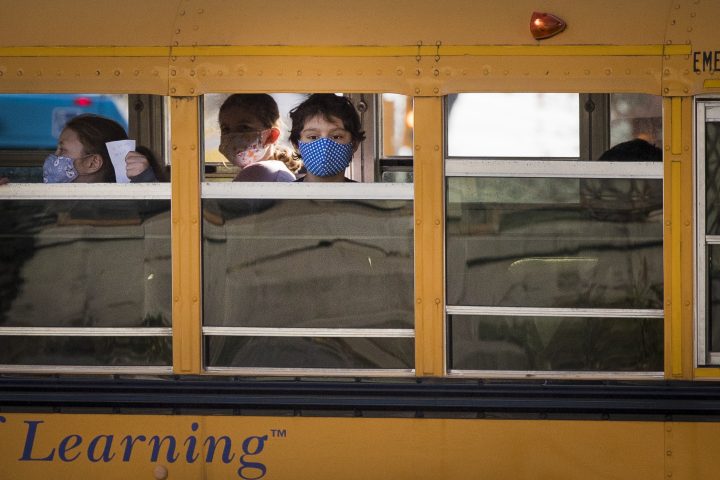Backpacks, pencils, books … masks?

Provincial governments in Atlantic Canada have all released their back-to-school plans as students gear up to head back to the classroom this September.
While there’s a desire to return to normal, there’s also the reality of a fourth wave of COVID-19 — driven by the Delta variant — in Canada.
Recently, the U.S. recorded a record number of children hospitalized with COVID-19 amid the Delta variant surge.
And while vaccinations have been touted as the best protection, Health Canada has still only approved the Pfizer vaccine for children aged 12 and over.
Provinces have taken a varied approach in how classrooms will look and whether educators will need to be vaccinated.
Here’s a closer look:
New Brunswick
The province is currently experiencing a rise in COVID-19 cases ahead of the back-to-school season.
- ‘FLiRT’ COVID-19 subvariant dominant in Canada. What to know about the strain
- ‘I am silenced’: Did Miss USA leave a secret message in her resignation?
- RateMDs faces certified class-action lawsuit over alleged breach of privacy
- Power adapters sold on Amazon may cause electric shock, Health Canada warns
As of Aug. 24 — exactly two weeks before the start of school on Sept. 7 — the province has 167 active cases
Education Minister Dominic Cardy and Regional Chief Medical Officer of Health Dr. Cristin Muecke have announced that students from Kindergarten to Grade 8 will be wearing masks in common areas. Students of all ages will be required to wear a mask on school buses.
The province as a whole is in the “Green phase” of its reopening plan and all restrictions, including mask mandates, have already been lifted.
Class sizes will return to normal, “bubbles” will be removed, and high school students will return to full-time, in-person learning.
Fredericton-based Dr. Kari Van Middlesworth spoke with Global News to voice her concerns about classroom capacity — saying she feels the situation is less safe for children now than it was at the height of the pandemic in March.
School and district staff will be required to be vaccinated or undergo regular COVID-19 testing. The president of the New Brunswick Teachers’ Association applauded this directive, and said up to 90 per cent of teachers may already be vaccinated.
Vaccination for students is strongly encouraged, and Cardy has said his department has not ruled out regular testing for students who choose not to be vaccinated.
On Aug. 24, the province announced it is expanding its vaccination eligibility to include children who are turning 12 this year.

Students who are immunocompromised or have a medical condition that prevents them from becoming vaccinated can have alternate arrangements with the education department.
Those without medical conditions will not.
“If a family chooses to take their student out of the public school system because they’re concerned for whatever reason, but they don’t have a medical reason, they’ll be making a choice to home school their children,” Cardy said.
Nova Scotia
The province is promising a “more familiar routine” when students return to school on Sept. 7.
While masks will be required in school buildings and buses at the start of the year, the province is slated to move into Phase 5 of its reopening plan on Sept. 15. At that point, schools will transition to making masks optional.
Parent Stacey Rudderham, who is part of a public education advocacy group, has told Global News that dropping mandatory masks in the early days of the new school year concerns her because students will no longer be required to stay in cohorts, or bubbles.

The province will strive to keep full in-class learning, and to bring back extracurricular activities such as music classes, band and sports.
Even the smallest routines — lockers and cubbies — will be back.
Meanwhile, the province vows to keep “ongoing inspections and maintenance” of school ventilation systems.
“Right now with the plan we have today, we feel that that keeps people safe,” said Premier-designate Tim Houston during his first government news briefing.
The Nova Scotia Teachers Union has said it supports the plan, although president Paul Wozney criticized the down-to-the-wire timing of the release.
Prince Edward Island
Prince Edward Island is also promising a “near-normal” return to school this fall.
Initially, the province announced masks were “recommended” for staff, students and visitors in common areas throughout the school, for staff in Kindergarten to Grade 6 where physical distancing is not possible, as well as on school buses.

However, on Aug. 27, the school boards said masking will now be required — not just recommended — for staff, students and visitors in all grades when moving through the school. Masks can be removed when seated in classrooms.
As well, the change in wording said masking will be “required” for staff in classrooms in Kindergarten to Grade 6 where physical distancing is not possible, and on school buses.
Generally speaking, the province’s mask mandate for public indoor spaces was lifted back on July 9.
Vaccination is “highly recommended” for all eligible staff and students, and pop-up immunization clinics will be open in schools as necessary.
Health officials have also said they will maintain targeted border screening, testing and self-isolation for unvaccinated travellers until at least the middle of October.
Chief Medical Officer of Health Dr. Heather Morrison said the border measures will remain a little longer to help support a safe return to school for children by keeping COVID-19 numbers low in the province.
The province will be running a training exercise for principals, administrators and others in the education system about what to do should a COVID-19 outbreak occur in a school.
Newfoundland and Labrador
Newfoundland and Labrador is using community transmission risk — designated as either low-risk or high-risk — to determine how the school year will look for each community.
“If current epidemiology is still in place on Sept. 8, all K-12 schools will start the school year in the low-risk designation,” the province noted in a news release.
Under low-risk designation, cohorts or “bubbles” won’t be necessary and neither will social distancing. Masking will be “still acceptable and encouraged” but not required. Buses would operate at normal capacity and masks would not be required. Extracurricular activities would resume and assemblies for students in Grades 7 through 12 are back on. Community groups would also be allowed to use schools.
However, under high-risk designation, cohort and physical distancing would be brought back, as well as the possibility of online learning. Mask use may resume, buses may have reduced occupancy and extracurricular activities would be “unlikely to occur.”
Regardless of the risk designation, the province says ventilation will be reviewed and sanitization protocols followed.
— with files from Nathalie Sturgeon, Tim Roszell, Alexa MacLean, and The Canadian Press




Comments